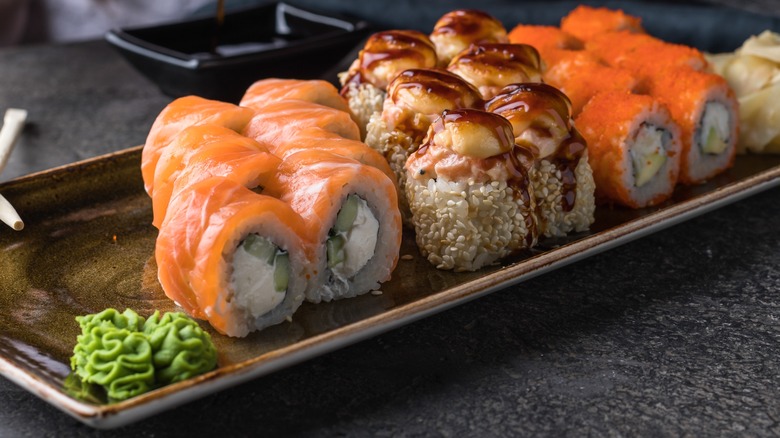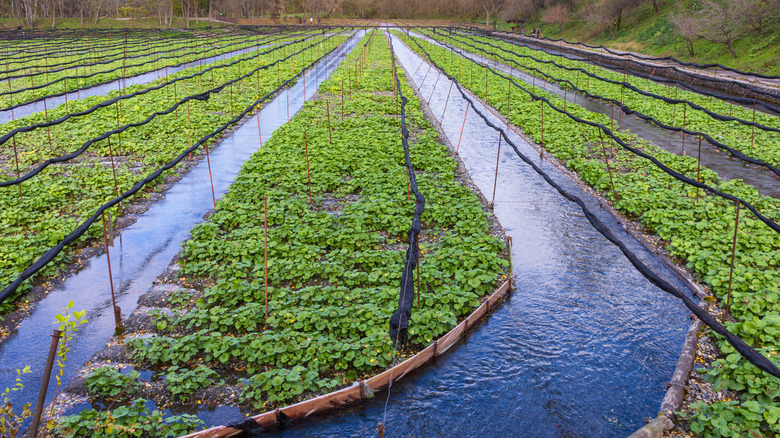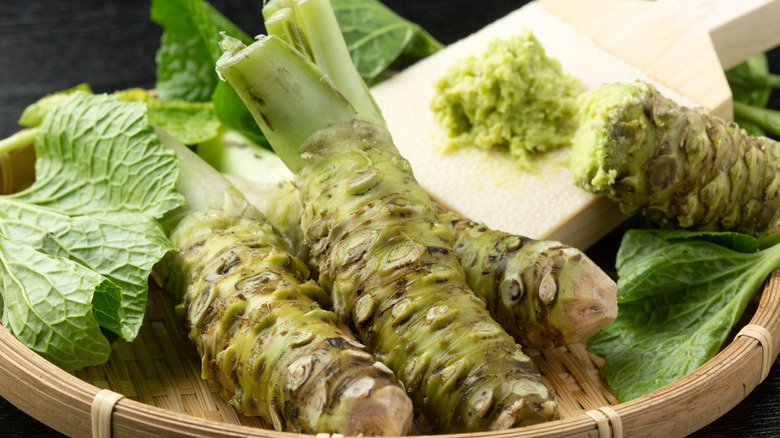The Wasabi Served At Restaurants Actually Isn't The Real Deal
If you love the fiery kick of wasabi on your sushi or wasabi peas, you may be surprised to learn that your wasabi paste may not contain real wasabi. Most wasabi pastes found in the United States are made from a blend of horseradish and mustard that is tinted green, according to Washington State University. Some contain a little authentic wasabi in addition to the horse radish, but real wasabi root is rare and costly, often costing upwards of $100 per pound.
When enjoying pseudo wasabi paste, you still feel the searing nasal sensation you expect. That's because real wasabi is related to European horse radish root. In fact, the plant is called wasabia japonica or Japanese horseradish. Wasabi, horse radish, and mustard each contain a compound called allyl isothiocyanate, per Science and Food. It's responsible for the heat that hits your nose first, rather than hitting your tongue like chili peppers.
While horse radish and wasabi deliver similar sensations, they are not the same. The compounds in wasabi are less stable, so while it delivers more of that fiery sensation immediately but doesn't last as long once exposed to air. Ideally, you would enjoy freshly grated wasabi within 15 to 30 minutes. While it may be disappointing to learn the wasabi paste you enjoy probably isn't authentic, it may help to understand why it is so rare.
Why real wasabi is so rare
Growing wasabi is difficult and requires very specific conditions. The plant is native to Japan and requires a specific moist and temperate climate to thrive. It originally grew wild in the valley of Mt. Bukkoku near Shizuoka City and required a constant supply of cool spring water, according to the Japanese government. Growers using traditional growing methods avoid the use of commercial agricultural chemicals like fertilizers.
For decades, Japanese cultivators have used a tissue culture method to propagate wasabi which is a sophisticated technique where the grower takes a small sample from an existing plant to form a new plant. While this method produces high-quality wasabi, a lot can go wrong, and around 60% fail, according to Washington State University. In other words, it is expensive and rare because it is hard to grow enough to meet the demands of sushi lovers around the world.
Outside of Japan, real wasabi is also now grown in regions with a similar temperate climate like parts of the American Pacific Northwest and New Zealand, per the University of California, Los Angeles. Although it is still rare and expensive, you may be able to find real wasabi if you look for it.
How to recognize and find real wasabi
Sometimes you can find authentic wasabi in restaurants outside of Japan, and you may even be able to find fresh wasabi root in your local Asian market or specialty grocery store. Some cultivators also sell it online.
Since you are most likely not used to the real thing, you may wonder how you will recognize it. Often when a chef serves real wasabi, they grate it 10 to 15 minutes before serving and mix it into a simple paste. Freshly grated wasabi tends to have a grittier texture than the more common wasabi paste, which is made from horse radish that was puréed until smooth. It's also a slightly more subtle shade of green, depending on how much of the root is grated into the paste. The hue isn't the only indication since some people purée the edible leaves into the wasabi paste for a more intense green and to enhance the flavor.
The flavor profile is also slightly different. Oregon wasabi grower Markus Mead told Oregon Public Broadcasting (OPB) there are two main types of wasabi consumed one that is a little sweeter, and the other is even more spicy.
"The flavor of real wasabi is so much richer, the heat more delicate, less sharp and playful in the mouth than the explosive and comparatively bland horseradish 'wasabi,'" Mead told OPB. "[It's] the difference between fresh-picked blueberries and a blue-colored snow cone."


